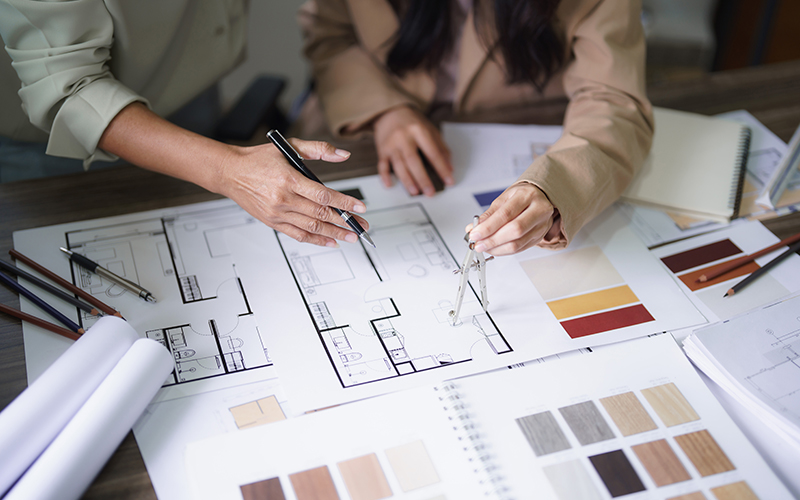Interior Design Decision Guide: Freelance Talent vs. Studio Expertise

Choosing the right interior designer can feel like a maze. One fact stands: interior design influences our experience of spaces. This article breaks down the choice between freelance designers and established design studios, helping you decide what suits your needs.
Learn more below.
Freelance Designers vs Design Studios
When choosing between a freelance interior designer or an established design studio, consider the flexibility and customization in the design process. Assessing resource availability and team dynamics can offer insight into project management.
Flexibility and Customisation in Design
Freelance designers offer unique perspectives and personalised designs that reflect individual tastes and lifestyles. Their autonomy allows them to turn visions into reality, aligning details with clients' interests and values. In contrast, established design studios provide a collaborative environment where creativity meets structure.
Studio teams collaborate, pooling diverse skills to create comprehensive designs that meet company standards and client requirements. While studios may limit individual expression, they guarantee a balanced approach that combines innovation with functionality, catering to a broader range of client needs.
Availability and Team Dynamics
Established design studios offer resources and team dynamics for collaborative efforts. They enhance creative visions with diverse insights and technical skills. The studio structure ensures efficiency and a streamlined workflow, ideal for clients seeking comprehensive service coverage.
Freelancers value creative freedom and direct client relationships, but they face limitations in resource availability and multitasking across project aspects, which can dilute focus from the main design objectives.
Studio designers benefit from shared responsibilities and learning opportunities from experienced colleagues. Freelancers may miss these opportunities without the same industry connections or teamwork.
Analysis
After exploring resources and team dynamics, we move to cost analysis. This aspect is crucial in deciding between a freelance interior designer or an established design studio, as both options have unique financial implications.
| Aspect | Freelance Interior Designer | Established Design Studio |
|---|---|---|
| Overhead Costs | Lower, due to savings on office space and employee salaries. | Its higher, as it includes office maintenance and staff salaries. |
| Fees | More competitive, benefits from lower operational expenses. | Higher reflects extensive experience and brand recognition. |
| Self-Employment Costs | Includes taxes, health insurance, and equipment investment. | The studios operational budget covers these, so it is not applicable. |
| Resource Access | Limited procurement can affect project costs due to individual procurement. | Greater, as bulk purchasing and industry contacts reduce prices. |
| Income Variability | Affects pricing strategy and leads to unpredictable project quotes. | Predictable income allows consistent pricing. |
| Marketing Costs | Higher, as establishing presence demands significant investment. | Lowering individual impact across projects. |
This table compares the financial differences between hiring a freelance interior designer and an established design studio. It highlights the balance between the customised, cheaper services offered by freelancers and the security, resources, and predictable pricing of established studios. For individuals planning to buy a property and considering interior design services, understanding these cost dynamics is paramount.
Managing Deadlines and Projects
Freelance designers manage deadlines through excellent time management. They must juggle multiple projects independently, which can lead to schedule clashes if not managed properly.
This requires high organisation and self-discipline due to the unpredictable workload and income of self-employment. Established design studios have dedicated project management teams to oversee each stage.
These teams ensure deadlines are met without compromising quality, thanks to structured workflows and teamwork. When tight deadlines approach, working within a studio means access to more resources for quicker problem-solving and decision-making.
Criteria for Your Choice
When choosing between a freelance interior designer and an established design studio, consider the project’s scale, budget, and long-term support needs.
Your decision will significantly impact your property's design journey. Read our blog for insights on making an informed choice for your interior design project.
Assessing Project Scale and Complexity
Freelance interior designers:
Operate solo. Evaluate each project's requirements to align with their abilities and interests
Cherish artistic liberty, allowing them to undertake various projects aligned with their objectives and work approach.
Choose projects that match their proficiency and creative vision.
Established design studios:
Due to a larger team and resources, provide alternatives for projects of all scales and complexity.
Ensure consistency by so any project receives care from diverse abilities.
Can handle substantial projects due to shared knowledge covering various interior design facets.
When selecting projects that align with their strengths, freelancers and design studios consider personal objectives, work style, stability, and artistic freedom.
-
Chennai Showroom
VIEW ON MAPS1st Floor, Plot, SRP Towers, 1032, 6th Main Rd,
Next to GBR Fertility Centre and Hospitals,
Mogappair Eri Scheme, Mogappair East,
Chennai, Tamil Nadu - 600 037.
-
Coimbatore Showroom
VIEW ON MAPS180, Thirugnanasambandam Rd,
Above Cream Centre, Gopalapuram,
Coimbatore, Tamil Nadu - 641 018.
Copyrights All Rights Reserved i5 Designs Website Designed & Developed By Glint Creatives.com